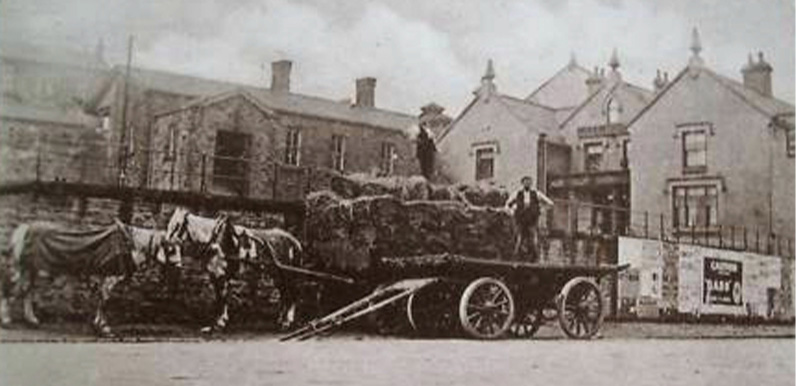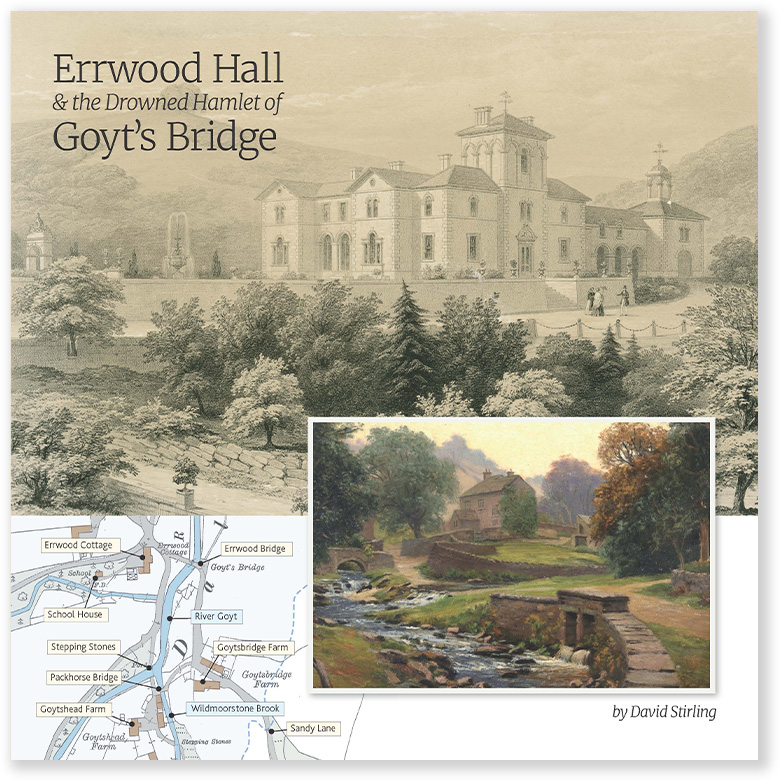Above: William’s body was taken on the back of a cart to The Cock public house. And this is where the inquest was held, just three days later.
By the time this photo was taken it had been renamed The Jodrell Arms. The pub has been in a very sorry state for over 10 years, lying derelict beside the railway station.
Photo courtesy of the Whaley Bridge Photos Website.
Following on from the previous instalment describing the brutal murder of William Wood on the road between Disley and Whaley Bridge, we move to the inquest. It was held in the Cock Inn in Whaley Bridge on Saturday 19th July, just three days after William’s body was discovered.
This report is taken from the 29th July 1823 edition of the Manchester Mercury. And copied from the Whaley Bridge Local History website, with kind permission from R.S-S.
Inquest on Mr Wood, of Eyam
On Saturday week, an Inquest was held at the house of Mr Sykes, the Cock Inn, Whaley, before John Hollins, Esq., Coroner, and a respectable Jury, on the body of this unfortunate man, who, as we stated in our last, was found barbarously murdered, at a place called Longside, on the old road from Disley to Whaley-Bridge, on the previous Wednesday evening, about half-past seven, on his return from Manchester Tuesday’s market, whither he had attended as a cotton manufacturer, and had received, as near as can be ascertained, £100, no part of which was found upon him.
The Jury and witnesses proceeded to view the body, which presented a horrid spectacle the face and head being savagely mutilated, and covered with gore. On the head were ten wounds, inflicted by some blunt instrument, many of a mortal kind, but the one which apparently produced death, was on the back of the head, by which the skull was severely fractured, and a part of it forced into the brain.
The following examinations were taken:
John Johnson, of Disley, stonemason
I live near the Bull’s Head Inn, on the old road between Disley and Whaley, about half a mile from the place where the body was found.
About seven o’clock last Wednesday evening, I saw two young men going towards Whaley; and behind them (at about 18 or 20 yards distance) the deceased and another man, going the same way.
The first two had dark coloured coats on, were below the middle size, and appeared about 18 or 19 years of age; the man with the deceased, had a light-coloured coat, a jacket, and trowsers of the same colour; he was taller than the other two.
They were all going towards the place where the deceased was found.
Joseph Hadfield, of Disley
I live on the side of the old road between Disley and Whaley. On Wednesday evening last, about seven o’clock, I was standing at my door, and observed the deceased walk by, towards Whaley, with an umbrella in his right hand and a bundle or basket, on his left arm.
About two or three minutes afterwards, I saw three young men walking after him; I cannot recollect their dress. The distance from my house to the place where the body was found, is about a quarter of a mile, and they were all going in that direction.
Edmund Pott, of Kettleshulme, labourer
On Wednesday evening last, I was returning back from Stockport with my cart and horses. I returned along the old road from Disley to Whaley.
When I came opposite to William Goodwin’s house (which is about a quarter of a mile from the road), I saw the body of the deceased, lying by the lower side of the road, quite dead, but warm; the blood then still flowing from the head. He could not have been dead many minutes.
It was then about eight o’clock. The head was very ill cut, and very bloody. Several stones lay at the back of the head, and they were very bloody. I lifted the body up, and brought it in my cart to the Cock Inn, in Whaley. Blood ran from the body in the cart.
(The stones were produced; they were pieces of rock stone, were all very bloody, with hair still sticking to them; one was of an oblong shape, and had the appearance of bloody finger marks at one end.)
Thomas Etchells, of Whaley
About half-past seven, or twenty minutes before eight (as near as I can judge,) last Wednesday evening, I was coming very slowly along the old road from Whaley to Disley, when I saw three men running along the road towards Whaley.
When they came within about forty yards of me, they ceased running, and walked; one of them asked me, how far it was to Chapel-en-le-Frith. I replied “four miles.” One of them said “thank you Sir.”
As soon as they passed me, they ran again, and continued to run till I ceased to look after them.
One of the men was a little taller than the other two; he wore a jean jacket, and had trowsers of the same. On his left arm, between the shoulder and the elbow, I saw a mark four or five inches long, the colour of blood.
The other two were rather lower than the other, and of about the same size of each other; they had darkish coats, and one had lightish coloured trowsers, narrow stripe; they were all very young men.
The place where I first saw these men is about half a mile from the place where the deceased was found; and they were running in a direction from that place.
John Johnson, of Whaley, wheelwright
On Wednesday evening last, about eight o’clock, I was standing at the side of the Smithy, at Whaley, opposite the end of the old road from Disley. I saw three men running down that road towards me. I concluded they were running a race.
They ran about a quarter of a mile in my sight; and ceased to run when they got near the Whaley Toll-gate. They went along the road towards Buxton.
Two of the men were about five feet seven or eight inches high, had dark coloured coats; I took them to be blue, I cannot say whether they had trowsers or not.
The other man was about two or three inches taller, had on a light coloured jacket, like jean; and trowsers of the same colour, with a white apron round his waist. He was thin. They all appeared about twenty years of age.
Henry Scott, toll bar keeper, at Whaley
On Wednesday evening last, between seven and eight o’clock, I saw three young men after they had passed a few yards through the bar; they were walking quick, along the road towards Buxton. They were of a moderate size, but I cannot say whether one was taller than the other.
One had a jacket and trowsers on, both light coloured; and he was without stockings. On the leg of his trowsers, towards the bottom, I saw blood, as well as upon his leg below the trowsers. The coats of the other two, were dark coloured.
William Wright, of Disley, surgeon
I have examined the body of the deceased and find ten wounds on the head–three on the forehead, and seven at the back. They are made by some blunt instrument.
One blow on the back of the head, has fractured the skull in three directions; the one an inch and a half long, and the others rather less; part of the skull is forced into the brain. This wound is calculated to produce instant death.
The four stones now produced, or any of them, would inflict such wounds as those I have found upon the deceased.
No other evidence appearing to identify the murderers, the Jury returned a verdict of wilful murder, against some person or persons unknown.
We are informed that several benevolent and well-disposed individuals, in consideration of the deep distress and poverty which the widow and an orphan child have been thrown into by the loss of a good husband and kind father, who had industriously and anxiously endeavoured to maintain his family comfortably and respectably, are soliciting subscriptions from the charitable and kind hearted; and the smallest donation, if left at our Office, will be transferred to the Rev. Gentleman of Eyam, who has kindly undertaken to become the treasurer for the disconsolate widow and helpless orphan*.
*Note: Some reports say William was a father of three children.
Previous: Part 2. Innocent or guilty? : Next: Part 4. The chase

